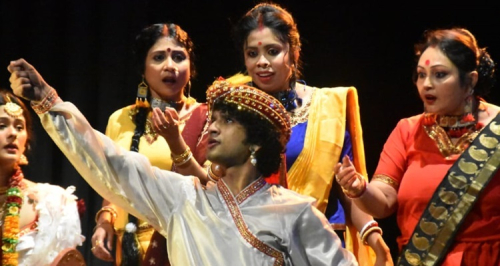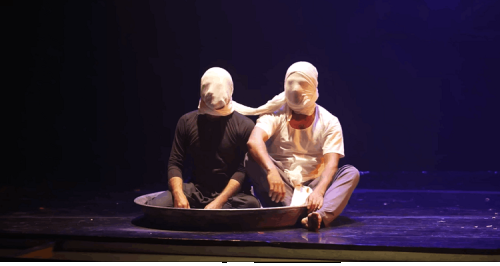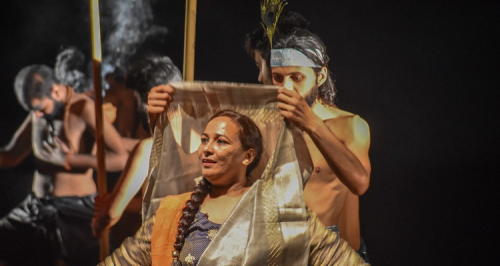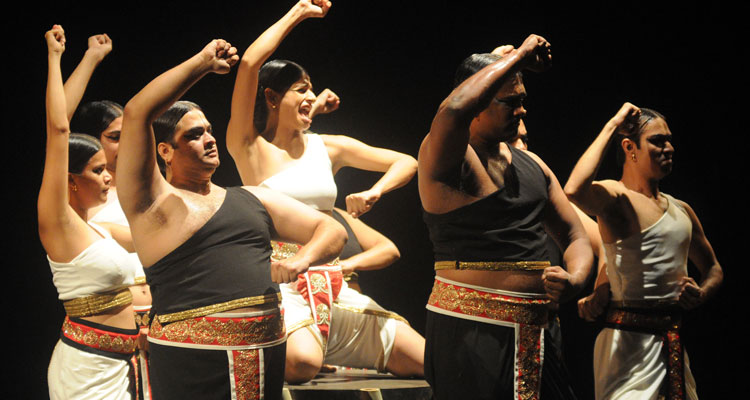Shikhandi: The Story of the In-betweens
The 13th edition of META engaged the audience in a continuous conversation over the past week on various subjects, including gender and mythology. Often, a distinction offered between ‘sex’ and ‘gender’ is that the former is a biological given while the latter is a societal construct. Shikhandi, the concluding play in this weeklong celebration of theatre, however, blurred the line between the two terms. The story of the in-betweens constantly drew attention to what lies between the legs and whether that is instrumental in deciding one’s space in society.
Shikhandi, written and directed by Faezeh Jalali, is a quirky adaptation of the story from Mahabharata, a fact that is referred to throughout the play as the live musicians belt out the famous signature tune from B.R Chopra’s television adaptation every time the epic is discussed. In this re-telling, post-Amba’s penance and the fall-out between Dronacharya and Dhrupad, Shikhandi born to Dhrupad as a transgender who identifies more with the feminine identity, is raised as a man to ensure that she can avenge her father: here lies her dilemma about identity as a prescribed norm.
The play really does idiot-proof itself as the protagonist constantly questions what is acceptable for her to do as a male and what is considered too feminine. The entire sequence at the Gurukul blatantly puts forward societal definitions of masculinity and femininity especially as it juxtaposes Shikhandi and her sister Gautami (Draupadi)- anomalies, as neither act as per their prescribed roles, often confusing their peers and Gurus resulting in the consequent ’othering’ of Shikhandi.
“…boys, girls and Shikhandi!” the teacher calls out in the music class.
While the play included clichéd sequences of ‘Don’t cry like a girl!’ and a constant repetition of words such as ‘pansy’ to describe Shikhandi, it was also riddled with some subtle tells that forced one to think about how ingrained these societal labels are. For example, the costumes in the play, a simple, unisex set of short dhotis and blouses, reinforced the message as most of the eight-member cast fluidly switched from one character to the other, often in the same scene, irrespective of gender roles.
The play itself refused to fit inside a box. The live musicians and the well-choreographed sequences brought to light the nautanki aspect of the play; the dialogue constantly shifted to the contemporary lingo and the play often showcased movement by using traditional forms of Bharatnatyam and Kalarippayattu.
The stage set up was simple with the use of two bamboo structures on either side of the stage. The costumes and the use of bamboo gave one the feeling that this was actually a play-act set in a forest, reminiscent of Shakespeare’s ‘idyllic forests’, (A Midsummer’s Night Dream and As You Like It), where societal order often broke down and the characters did as they willed. While Shikhandi did not shy away from showcasing and discussing the human anatomy, certain plot points were presented extremely skillfully. The sash, for example, worn by all the actors was exchanged between Shikhandi and the Yaksha to represent the sex change. The conflict between two characters embodying two opposing views was often portrayed through a corridor of light spread diagonally across the stage with the two characters on either end of the spectrum again questioning our need to categorize everything as either/ or; black/ white.
The play raises some interesting points on the very narrative of Mahabharata that has relentlessly been adapted, reinterpreted and studied throughout the years. At one point, Shikhandi is thankful that her story even made the larger epic. The play chooses to draw attention to the fact that at the end, Amba was only able to get her revenge on Bhishma in the garb of a man and only because Bhishma refused to raise arms against a woman- a point that is often celebrated about the warrior.
The pace of the play in terms of the amount of content the audience is expected to digest in 90 minutes is overwhelming! The constant shift from English to Hindi to some Marathi, mixed with some contemporary slang, while you are trying to keep track of the various characters and the larger narrative had your head spinning. One also does question the obviousness this narrative tends to play with and whether it was necessary to portray everything through extremes. Why must Gautami/Draupadi be the masculine to Shikhandi’s feminine? Why are the Pandavas depicted as sex addicts who shake at the thought of war and require Draupadi to strategize for them?
However, Shikhandi successfully shocked the audience into questioning pre-existing ideas on gender roles while celebrating the cause of the LGBT community. With an ensemble of some of the best-known actors in the theatre circuit, Shikhandi was a fitting end to the ‘Drama in Diversity’, a week of META that was





Leave a reply